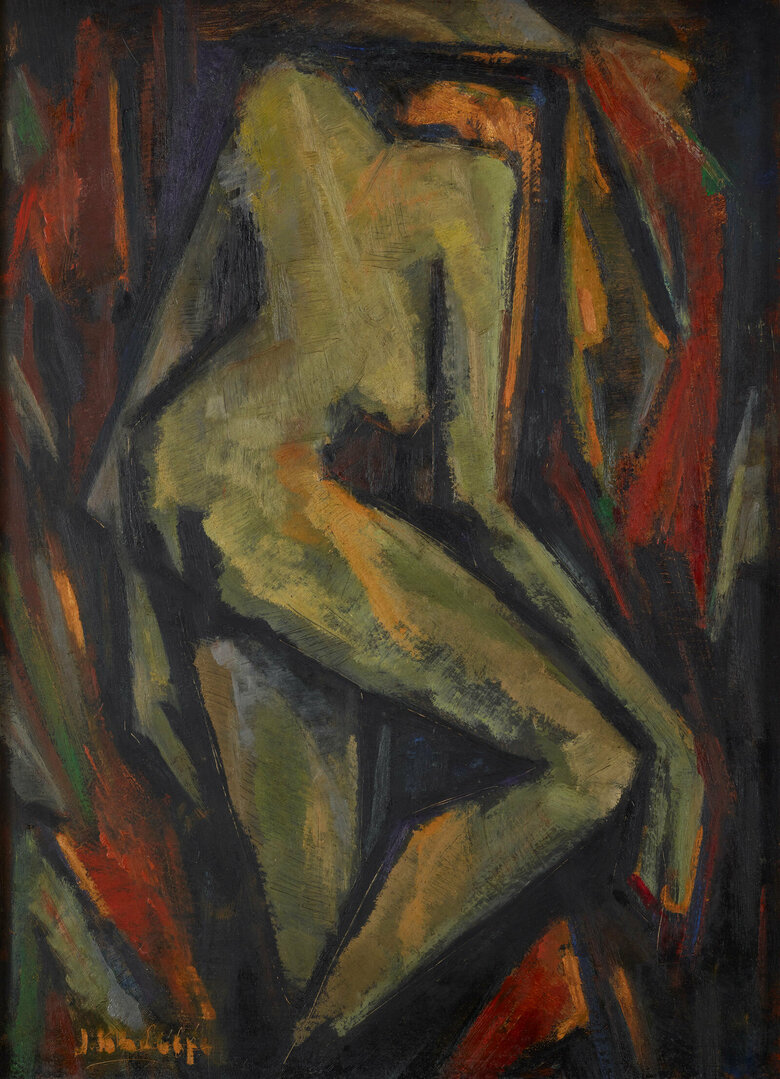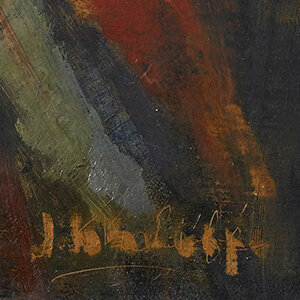Jean Khalifé, an important figure in modern Lebanese art, was born in 1923 in a village in northern Lebanon called Hadtoun. His artistic journey began at the Collège des Frères Maristes in Jounieh....





Jean Khalifé, an important figure in modern Lebanese art, was born in 1923 in a village in northern Lebanon called Hadtoun. His artistic journey began at the Collège des Frères Maristes in Jounieh....
Jean Khalifé, an important figure in modern Lebanese art, was born in 1923 in a village in northern Lebanon called Hadtoun. His artistic journey began at the Collège des Frères Maristes in Jounieh. Despite an initial reluctance of pursuing art as a career, Khalifé remained steadfast in his resolve to become a painter, declaring it as the only path for him[1]. This determination led him to the Lebanese Academy of Fine Arts (ALBA) where he studied under the tutelage of the Beirut-based Italian painter Ferdinando Manetti and the influential Lebanese artist Cesar Gemayel, between 1947 and 1950. The following four years led Khalifé to Paris, where he refined his craft while studying at the Ecole Nationale Supérieure des Beaux-Arts as well as the Académie de la Grande Chaumière. In 1962, Khalifé married Odette Aad and they had their son, Jim, who continues to look over his father’s artistic estate till today.
Jean Khalifé's career is marked by a notable array of exhibitions and honors. He has participated in 65 individual and group exhibitions across Lebanon, France, England, Italy, Syria, Japan, and Brazil. His works are held in high esteem and can be found in various museums, foundations, and private collections such as the Sursock Museum in Beirut Lebanon, and the Abraham Karabajakian collection also based in Beirut.
Khalifé's style evolved significantly over the years. Initially influenced by impressionism through his teacher César Gemayel[2], he later gravitated towards abstract expressionism. His early works were deeply rooted in the natural landscapes of the village of Hadtoun, Batroun District –capturing the vividness of color and the fluidity of form. This influence is evident in his landscapes and portraits, where he masterfully blended traditional techniques with his unique vision as seen in his 1975 oil painting Mon Village[3].
One of Khalifé’s notable contributions to the art world is his shift towards non-figurative abstraction in the 1950s – a move that was initially met with criticism. Unperturbed, he continued to develop his style, characterized by vigorous brushstrokes, bold compositions, and a vibrant color palette. His works from this period, such as those exhibited in his 2023 centenary exhibition Hidden Treasures at L’atelier Maher Attar[4], exemplify his mastery of color and form. This exhibition, organized by Tony Karam, showcased previously unseen works, revealing Khalifé's innovative approach to abstraction and his ability to evoke powerful emotions through his art.
Khalifé's oeuvre is diverse, encompassing various mediums such as oil, tempera, pastels, and watercolors. His works on board, done in tempera and pastels, are particularly noteworthy for their intricate detail and vibrant use of color. Of his technically masterful works are his auto portraits, specifically Autoportrait[5], 1976, done with oil on Masonite, described as part of the artist’s last period. Jean Khalifé had the ability to capture people descriptively, despite his abstract approach. He was able to depict his subjects' essence and physicality. This suggests an artist who perceives beyond one dimension, incorporating the second and third dimensions in his work. During that period, he often painted portraits of his colleagues such as Portrait Michel Basbous[6], 1976, and Portrait Georges Shehade[7], 1976.
His technique often involved a lyrical abstraction, where the dynamism of movement in space was linked to the spontaneity of his brushstrokes. This approach allowed him to create a sense of rhythm and unity in his paintings, drawing viewers into a world of abstract forms and vibrant colors. Khalifé’s use of staccato[8] rhythm, characterized by abrupt changes and dynamic contrasts, is evident in many of his works, adding a sense of energy and movement to his compositions. These techniques are most noticeable in his abstract compositions done in the late 1970s, such as Composition[9], 1977. He often used the expression
"I like to draw like birds sing" [10],
originally quoted by Claude Monet, emphasizing the joy and freedom he found in painting. This sentiment reflects his desire to create art instinctively and expressively, similar to how birds sing without concern or premeditation evident in these abstract compositions.
In addition to his contributions to abstract art, Khalifé also explored themes of femininity and nature. His portraits of women, often depicted in vibrant, expressive colors, reflect his deep appreciation for the female form and its symbolic significance. These works, characterized by their emotional depth and artistic innovation, remain some of his most celebrated pieces. Jean Khalifé’s Lassitude, 1949, part of the Ramzi and Saeda Dalloul Art Foundation, is an exemplary piece from his first period (1949-1959). The artwork showcases his early mastery of form and color, combining vibrant hues with a dynamic composition that evokes both emotion and movement. The use of oil on canvas highlights his skillful technique, blending traditional elements with a modernist approach. The detailed brushwork and careful attention to light and shadow create a vivid and immersive scene, characteristic of Khalifé's dedication to his craft.
Jean Khalifé’s impact on the art world extends beyond his innovative techniques and vibrant compositions. He played a pivotal role in the development of modern art in Lebanon, inspiring a generation of artists to explore new forms of expression. His ability to convey deep metaphysical themes through his art have earned him recognition as a pioneer of abstract art in Lebanon. Khalifé’s paintings, often imbued with symbols and allegories, invite viewers to engage in personal interpretation, reflecting his thorough understanding of the human condition and the complexities of existence. His leadership as the president of the Association of Lebanese Artists and his contributions to art education have left a lasting mark on the Lebanese art scene.
Jean Khalifé passed away of a heart attack in 1978, while painting in his studio. The artist’s journey from a small village in northern Lebanon to international acclaim reflects his dedication to his art. The creation of the Jean Khalifé Museum in 1979, in his native village of Hadtoun testifies of the Lebanese state's recognition of his contributions to art. This museum, dedicated to preserving and showcasing his works, serves as a source of inspiration for future generations of artists and art enthusiasts.
Today, Khalifé’s works continue to captivate audiences, evoking emotions and sparking the imagination. As Khalifé himself once said, "The outside world is only an accessory. I carry my paintings within me as if they were anchored in my skin"[11], a sentiment that summarizes the profound connection between his inner world and his artistic creations.
Edited by Elsie Labban
Sources
“Masterpieces | Jean Khalife Artist Painter | Zouk MosbehHome.” n.d. Jean Khalife Art Paintings World. Accessed July 8, 2024. www.jeankhalife.com
سلطان, مهى . 2023. Review of حوار بين ريشتين... في مئويّة الفنانيَن جان خليفة وهلن الخال. Annahar, May 18, 2023. https://shorturl.at/2IIp4
“One Fine Art | Direct Sale - Jean Khalifeh.” n.d. Www.onefineart.com. Accessed July 8, 2024. https://www.onefineart.com/direct-sale/Jean-Khalifeh.
bcurryprecision. 2013. “Principles of Design – Unity and Rhythm.” Precision Art Blog. November 5, 2013. www.precisionartblog.wordpress.com.
“HIDDEN TREASURES, JEAN KHALIFE - Agenda Culturel.” n.d. Www.agendaculturel.com. Accessed July 5, 2024. www.agendaculturel.com
Notes:
[1] “Biography | Jean Khalife Artist Painter | Contemporary Art | NudesBiography.” n.d. Jean Khalife Art Paintings World. Accessed July 5, 2024. https://www.jeankhalife.com/biography.
[2] سلطان, مهى . 2023. Review of حوار بين ريشتين... في مئويّة الفنانيَن جان خليفة وهلن الخال. Annahar, May 18, 2023. https://shorturl.at/2IIp4
[3] “1st Period (1949-1959) | Jean Khalife Artist | Modern Painter1st Period (1949-1959).” n.d. Jean Khalife Art Paintings World. Accessed July 8, 2024. www.jeankhalife.com.
[4] “HIDDEN TREASURES, JEAN KHALIFE - Agenda Culturel.” n.d. Www.agendaculturel.com. Accessed July 5, 2024. www.agendaculturel.com
[5] “The Last Period (1975-1978) | Jean Khalife Artist PainterLast Period (1975-1978).” n.d. Jean Khalife Art Paintings World. Accessed July 5, 2024. www.jeankhalife.com
[6] “The Last Period (1975-1978) | Jean Khalife Artist PainterLast Period (1975-1978).” n.d. Jean Khalife Art Paintings World. Accessed July 5, 2024. www.jeankhalife.com
[7] “The Last Period (1975-1978) | Jean Khalife Artist PainterLast Period (1975-1978).” n.d. Jean Khalife Art Paintings World. Accessed July 5, 2024. www.jeankhalife.com.
[8] Bcurryprecision. 2013. “Principles of Design – Unity and Rhythm.” Precision Art Blog. November 5, 2013. www.precisionartblog.wordpress.com.
[9] 2021. Onefineart.com. 2021. www.onefineart.com
[10] “Biography | Jean Khalife Artist Painter | Contemporary Art | NudesBiography.” n.d. Jean Khalife Art Paintings World. www.jeankhalife.com/biography.
[11] “His Words | Jean Khalife Artist Painter | Nudes Paintings | AbstractsHis Words.” n.d. Jean Khalife Art Paintings World. Accessed July 8, 2024. www.jeankhalife.com/hiswords.
Selected Solo Exhibitions
Hidden Treasures – Jean Khalife's 100 Years Birthday with more than 60 Ureleaved Masterpieces, L'atelier Maher Attar, Gemmayze, Beirut
Hidden Treasures – Jean Khalife's 100 Years Birthday with 11 Symbolic Masterpieces, Lebanese American University (LAU), Beirut, Lebanon
Retrospective Exhibition in Homage to Jean Khalifé, Nicolas Ibrahim Sursock Museum, Beirut, Lebanon
Le NU Chez Jean Khalifé, Gallery Les Cimaises, Diéval, France
Drawings, Gallery One, Beirut, Lebanon
Modulart gallery, Beirut, Lebanon
Universe, St. Georges Hotel, Beirut, Lebanon
First solo exhibition, Gallerie Camille Mounsef, Beirut, Lebanon
Selected Group Exhibitions
Beyond Raptures, a Tentative Chronology, Nicolas Ibrahim Sursock Museum, Beirut, Lebanon
Beirut And The Golden Sixties: A Manifesto Of Fragility, Mathaf – Arab Museum of Modern Art, Doha, Qatar
Traces of Drawings: Nabu Museum Opening, Nabu Museum, Hereh, Batroun, Lebanon
The Road of Peace, Beirut Art Center (BAC), Beirut, Lebanon
Gallery Damo, Antelias, Lebanon
Museo del Folklore Romano, Rome, Italy
Ashmolean Museum, Oxford, United Kingdom
The Middle East Artists, Institut du Monde Arabe, Paris, France
Lebanese Academy of Fine Arts (ALBA), Beirut, Lebanon
Collections
Nicolas Ibrahim Sursock Museum, Beirut, Lebanon
Ramzi and Saeda Dalloul Art Foundation (DAF), Beirut, Lebanon
American University of Beirut (AUB), Beirut, Lebanon
Ashmolean Museum, Oxford, United Kingdom
Join us in our endless discovery of modern and contemporary Arab art
Get updates from DAF
Follow Artists
Save your favourite Artworks
Share your perspectives on Artworks
Be part of our community
It's Free!
We value your privacy
TermsCookiesPrivacy Policies
Get updates from DAF
Follow Artists
Save your favourite Artworks
Share your perspectives on Artworks
Be part of our community
It's Free!
We value your privacy
TermsCookiesPrivacy Policies
Get updates from DAF
Follow Artists
Save your favourite Artworks
Share your perspectives on Artworks
Be part of our community
It's Free!
We value your privacy
TermsCookiesPrivacy Policies
If you have entered your email to become a member of the Dalloul Art Foundation, please click the button below to confirm your email and agree to our Terms, Cookie & Privacy policies.
We value your privacy, see how
Get updates from DAF
Follow Artists
Save your favourite Artworks
Share your perspectives on Artworks
Be part of our community
It's Free!
We value your privacy
TermsCookiesPrivacy Policies